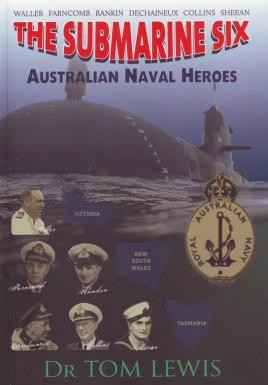In the last three decades the Royal Australian Navy has moved from naming its ships and boats after Australian cities and towns and used them to honour its members who were naval heroes.

Paperback 192pp RRP $19.95
Tom Lewis has retold the life stories of six heroes, none of who were ever submariners, but have had all of the six Australian-built Collins Class submarines named in their honour.
John Collins graduated in 1916 from the first course at the Royal Australian Naval College at Jervis Bay. He served with distinction between the World Wars and particularly as a cruiser captain in World War II. In 1948 he was appointed Chief of the Naval Staff, was promoted Vice Admiral in 1950, and knighted the following year. The submarine class was named after Sir John Collins and the first one launched in 1993 bears his name.
The remaining five submarines were launched between 1995 and 2001 by relatives or descendants of the five heroes.
Captain Hector Waller, DSO and Bar fought a valiant battle on his light cruiser HMAS Perth against overwhelming odds in the Sunda Straits (Indonesia). Torpedoed and sinking, he was still on the bridge when a direct artillery hit ended his life.
Captain Emile Dechaineux, DSC was known as ‘fearless and ferocious’. He had as his final command the aircraft carrier HMAS Australia. In October 1994 it came under heavy aircraft fire that saw its captain mortally wounded. He was appointed an Officer in the Legion of Merit (US) soon after his death.
Ordinary Seeman Teddy Sheean was a loader on an Oerlikon anti-aircraft gun, and rather than leave HMAS Armidale as it was sinking from Japanese air-launched torpedoes, strapped himself to the gun seat and continuing firing. This resulted in the downing one of the assaulting dive bombers. He was posthumously ‘Mentioned in Despatches’.
Lieutenant Commander Robert Rankin was escorting a convoy on the sloop HMAS Yarra in Mar 1942 when confronted by three Japanese cruisers and two destroyers. He turned the Yarra towards them, making smoke so the convoy could escape. Rankin and almost all his officers were killed by an 8-inch shell hitting the bridge. HMAS Yarra sunk two hours later.
Rear Admiral Harold Farncomb, CB, DSO, MVO was known as ‘Fearless Frank’. He entered the RAN Naval College in its first intake (with John Collins). He served with distinction between the Wars, commanded the heavy cruiser HMAS Canberra in 1940, HMAS Australia as Flag Captain during the Battle of the Coral Sea in 1942. In 1944 he commanded the British aircraft carrier HMS Attacker supporting Operation Dragoon during the invasion of French towns. In October 1945 he became Commanding Officer of the Naval College before serving as Flag Officer Commanding the Australian Squadron, and in a diplomatic posting until retirement in 1951.
Lewis goes to great lengths to discuss the unrecognised valour of the four who lost their lives. When their actions are compared to their Royal Navy counterparts who were awarded the Victoria Cross for similar actions, he claims three of them should been given the same honour. The difficulties encountered in raising reports whilst at sea in war, the witness requirements, and the torturous administrative path through the Royal Australian Navy, prior to British Admiralty approval before submission to the Sovereign, has seen no VC awarded to any member of the RAN. Subsequent submissions in recent times have not met with success, and (another) current one pertaining to Teddy Sheean is still to be resolved.
This very high-quality production is filled with anecdotes from witnesses, RAN personal reports, maps, excellent black and white photographs and all six submarines in colour plates. The work commences with a Glossary and Naval life as it was prior to and during the Second World War. The chapters on the six mariners have succinct summaries of their lives and achievements before Endnotes. There is a complete coverage of the specifications of all the vessels mentioned in the body of the text. The work is rounded off by an extremely comprehensive List of Works Consulted and Index.
A most readable account of the lives of six men who gave so much and have, in the main, been had their deeds unrecognised. Submarine Six has placed before us the incredible deeds of men most Australians have never heard of.
Reviewed for RUSIV by Neville Taylor, May 2020
Contact Royal United Services Institute about this article.






